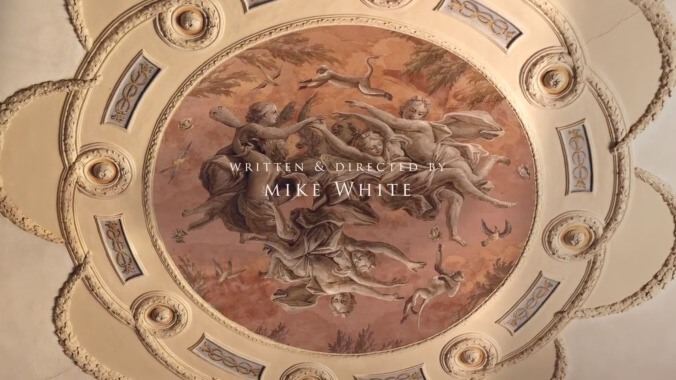Were clues to the ending of The White Lotus season 2 hiding in the credits all along?
Now that season 2 is all over, a closer look reveals just how much was lurking in those freaky frescos

Spoiler warning: The following contains spoilers for the seventh and final episode of The White Lotus season two.
One of the pleasures of tuning in to The White Lotus these past two seasons has been the evocative title sequences. Customized to suit the theme and setting of each season, they serve as a map of sorts, providing clues and winking references that set the tone for the episodes to come. It didn’t take long for fans to figure out that the wallpaper images in season one corresponded to the suites the characters were staying in: Palm, Hibiscus, Pineapple, and Tradewinds. There were other references too, like the rotting fruit next to Steve Zahn’s name symbolizing his character’s testicular cancer scare.
Directors Mark Bashore and Katrina Crawford of Plains of Yonder studio were the creative minds behind the opening credit sequences for both seasons. Working with The White Lotus creator Mike White, they incorporated actual Italian frescoes from the palazzo Daphne and Harper visited in episode three, with some purposeful alterations. They’ve said that nothing in the credits is accidental, and to especially pay attention to the symbolism of the animals which appear throughout. Now that the second season is complete, we can go back with the benefit of hindsight and catch some of the hidden clues we missed the first time around.
Woman and monkey/Man and woman on a donkey
This image of the woman looking wistfully out a window at a monkey on a chain goes along with Jennifer Coolidge’s credit. It’s the second image we see in the sequence after the Renaissance couple that accompanies F. Murray Abraham’s name. There’s a hint of fantasy and danger here, alluding to a potential fall from a high place, which is how Tanya met her ultimate fate. The monkey is on a chain, projecting the illusion of control, yet it remains a wild animal. Tanya felt like she was in control, but was being played from the start. Is she the woman or the monkey? Maybe she’s a little bit of both. Another clue to her situation can be found later, in the image that goes along with Jon Gries (who plays Greg). We see a man and a woman riding a donkey. The man is in the lead, taking her for a ride, while she holds on for dear life. That was Tanya this season in a nutshell, pretty much.
A pair of cherubs
The scene pans to two decorative putti in relief next to the credit for Meghann Fahy. This didn’t really provide any clues as to Daphne’s ultimate fate, but it could tell us something about her character. Traditionally, these angelic figures represent love and passion, but they could also be taken literally as references to Daphne’s children (who may not even be Cameron’s). In Renaissance art they’re often placed around the edges of paintings and sculptures, objectively observing from above, beside, and below. Daphne, too, keeps herself at a distance from her husband’s extra-marital activities, compartmentalizing and dissociating so much that she’s practically become an objective observer herself.
Classical Grecian figures
We see several figures pointing to a man holding a branch, or possibly a grapevine, sitting on what looks like a throne when Tom Hollander’s name appears. He may be the god Dionysus, or Bacchus since we are in Italy, presiding over the revelry of his followers, as both he and Quentin are wont to do. The figures could also be pointing to the mastermind of this murder plot. He wields all the power, just as he uses his powers of influence to woo Tanya into the trap he and Greg set for her. Also, let’s not forget that he ended up being one of the deaths alluded to at the beginning of the season. These figures were literally telling us the answer to the question of “Who will die this season?” This guy!










![Rob Reiner's son booked for murder amid homicide investigation [Updated]](https://img.pastemagazine.com/wp-content/avuploads/2025/12/15131025/MixCollage-15-Dec-2025-01-10-PM-9121.jpg)

























![HBO teases new Euphoria, Larry David, and much more in 2026 sizzle reel [Updated]](https://img.pastemagazine.com/wp-content/avuploads/2025/12/12100344/MixCollage-12-Dec-2025-09-56-AM-9137.jpg)



